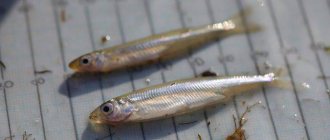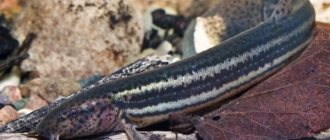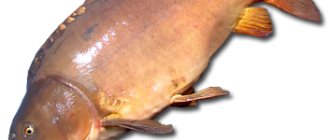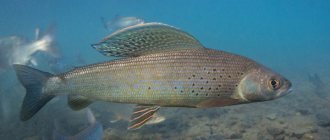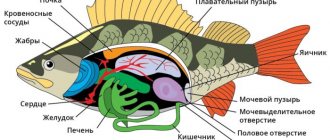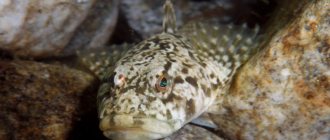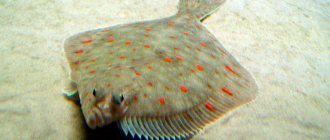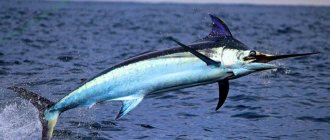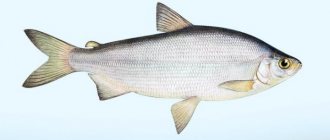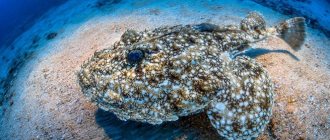- Wild animals
- >>
- Fish
Grouper fish is one of the most interesting and unusual marine inhabitants. Today, scientists count about a hundred species of grouper. Some of them are real giants, weighing half a ton and up to three meters long. There are also species whose body size does not exceed several tens of centimeters. Different representatives of the species have not only different sizes, but also appearance and lifestyle. This fish is highly valued among gourmets due to its unusual, delicate taste and special aroma. In addition, its meat is practically devoid of calories and enriched with vitamins and minerals. The fish is found under the name mirow or black.
Origin of the species and description
Photo: Grouper
Grouper is classified into the phylum Chordata, class ray-finned fish, order Perciformes, family rock perch, genus grouper.
The lifestyle, features of vital activity and stages of evolution of the rock perch have not been thoroughly studied. However, scientists and researchers have determined that these representatives of marine flora and fauna appeared about five million years ago. The appearance of the Isthmus of Panama about 3 million years ago contributed to the division of fish into two subspecies due to the division of the population territorially.
Video: Grouper
In the process of adapting to new conditions of existence and in the process of evolution, the grouper has learned to change its body shape and color in order to camouflage itself and remain unnoticed in the event of approaching danger. Also, in the process of evolution, the shape and structure of teeth have changed somewhat. They are arranged in several rows and are somewhat reduced in comparison with the original size.
Scientists note that grouper is one of those representatives of marine flora and fauna that have practically not changed since their appearance. In the process of distribution, fish were divided into many subspecies, each of which acquired distinctive external characteristics, characteristic features of behavior and lifestyle.
Plum tkemali with hop-suneli seasoning
Not only are delicious desserts made from plums; this berry is actively used in the Caucasus in the preparation of tkemali sauce. Plums are boiled together with herbs, hop-suneli spice, garlic and hot pepper. This recipe can be safely added to the list of preparations for the winter and then you will always have a natural sauce on your table for any dishes.
Cooking time: 50 min.
Cooking time: 30 min.
Ingredients:
- Plums – 1 kg.
- Garlic – 100 gr.
- Chili pepper – 1-3 pcs.
- Sugar – 3 tbsp.
- Salt – 1 tbsp.
- Allspice – 3 pcs.
- Coriander – 1 tsp.
- Bay leaf – 2-3 pcs.
- Balsamic vinegar – 1 tbsp.
Cooking process:
- Wash the plums thoroughly under running water, cut them in half and remove the pits. Wash the hot peppers and remove seeds. Peel the garlic.
- Separately, pass the garlic through a meat grinder.
- And then swirl the plums and chili peppers together. Add sugar, salt, allspice, coriander and suneli hops to this mass, stir and transfer the mixture into a saucepan. Place the preparation on the fire; when cooking the sauce, foam will form, which must be removed.
- Once the sauce boils, cook for 10 minutes, stirring constantly. Then add the garlic and vinegar and continue cooking for another 10 minutes.
- Wash the jars for seaming tkemali with soda and sterilize. Place the hot sauce into jars and seal them. Store tkemali in a cool place.
Appearance and features
Photo: Grouper fish
Regardless of the subspecies, size and region of habitat, all groupers are characterized by certain features that unite them.
Characteristics of groupers:
- large, massive body, somewhat flattened laterally;
- gill covers with spines;
- huge oral cavity;
- the presence of one spiny fin on the surface of the back;
- the presence of three spines on the anal fin;
- the teeth are short and very sharp, arranged in several rows.
This type of perch is called stone perch because of its external similarity to bottom boulders. This is not even explained by the huge size of the body, but by the specific coloring, which is very similar to rocks, stones and coral reefs. There are many dots, circles, stripes, etc. on the body of fish.
Fish also has a number of specific characteristics that distinguish it from other representatives of marine flora and fauna.
Features:
- small, round eyes;
- a huge, wide head part, against which the eyes seem especially small and insignificant;
- Almost all grouper individuals are hermaphrodites. They have an ovary to produce eggs and a testis to produce the cells that fertilize them;
- Body sizes can reach from 10 centimeters to three meters.
Interesting fact: Fish are endowed with the ability to change color and body shape for the purpose of camouflage.
The body weight of one adult individual depends on its size and ranges from 10-20 to 350-400 kilograms. The color can be very diverse, from bright, rich red to mottled, gray or brown. It depends on the region where the predator lives. The oral cavity is very large, slightly pushed forward. It is framed by skin growths that give the shape of pronounced lips.
Groupers, rockfish and others. Polyprionic and serranic Adriatic.
Some of the most common coastal trophies of spin fishing enthusiasts in the Adriatic are small representatives of the rock perch or serranidae family, and one of the most coveted ones are their older brothers from the same family.
rock perch family , or serranidae , includes 75 genera and about 550 species of fish. Their sizes vary from 10 centimeters and several tens of grams of weight to more than impressive sizes. The largest fish of the family is the Indian Ocean small-eyed grouper (Epinephelus lanceolatus), which lives in the Indian and Pacific oceans, reaching a length of up to 2.7 meters and a weight of about 400 kilograms.
(Gyotaku with grouper. Photo by JG Wang. flickr.com/photos/pcfannet/66213323)
However, the most popular among anglers is probably the guasa, or Atlantic giant grouper (Epinephelus itajara), which is also known by its English name goliath (Atlantic goliath grouper). This fish has become widely known thanks to the large number of photographs and videos taken by divers and fishermen off the coast of Florida (USA), Brazil and other countries on the Pacific coast. Guasa grows up to 2.5 meters in length and more than 360 kilograms in weight.
(Guasa, or Atlantic giant grouper. Photo © Walt Stearns. xray-mag.com)
Serranidae live in all tropical and subtropical seas of the world, most often staying near reefs or near rocky bottoms. The vast majority of fish are ambush predators; they have a powerful body, a large mouth with several rows of small teeth.
Most of the fish in the family are hermaphrodites, which are characterized by dichogamy; females eventually become males.
In the Adriatic Sea there are 10 representatives of the family from 2 subfamilies and 3 genera.
The subfamily Serraninae includes 13 genera, one of which is the genus of rockfish (Serranus), which unites 30 species of small fish living in the Atlantic, Pacific and Indian oceans. Ambush predators that are hermaphrodites. Three representatives of the genus live in the Adriatic:
Hanos , or stone perch - hanos (Serranus cabrilla).
(Janos, or janos rockfish. Photo © Sacha Lobestein. enelmar.es)
It lives at a depth of 5-500 meters, most often up to 50 meters. It lives near rocky, sandy and muddy bottoms, also in posidonia thickets. The maximum recorded length is 40 cm, specimens up to 25 cm are more common. The maximum weight is about 500 grams. It feeds on fish, cephalopods and crustaceans. Permanent inhabitant of the Adriatic Sea.
Mediterranean rock bass (Serranus hepatus).
(Mediterranean rockfish. Photo © Robert A. Patzner. fishbase.org)
It lives at a depth of 5-100 meters. It stays near the sandy, muddy bottom among stones and thickets of sea grass. The maximum recorded length is 25 cm; specimens up to 15 cm are more common. It feeds on crustaceans, mollusks and small fish. Permanent inhabitant of the Adriatic Sea.
Rockfish - zebra , or cuckoo (Serranus scriba).
(Zebra rockfish, or cuckoo. Photo © Xavi Lindo. xavilindo.cat)
It lives at a depth of 1-150 meters, usually up to 30 meters. It lives near the rocky bottom, often in posidonia thickets. The maximum recorded length is 36 cm, specimens up to 25 cm are more common. The maximum weight is about 600 grams. It feeds on fish and crustaceans. Permanent inhabitant of the Adriatic Sea.
About 90 species of fish include the genus grouper , or black , or merow (Epinephelus) from the subfamily Epinephelinae , which includes 22 genera. Their sizes vary from 20 centimeters to more than 2.5 meters, weight - from 100 grams to 400 kilograms. Mainly distributed in the Indo-Pacific region. The color of groupers is variable and can change depending on environmental conditions. A characteristic feature is the structure of the upper jaw, which can move forward strongly, due to which the shape of the mouth takes the form of a tube and allows the fish to suck in prey with force. In the Adriatic Sea there are 5 representatives of the genus:
White-striped Merow (Epinephelus aeneus).
(White-striped merrow. Photo © bastia-offshore-fishing)
It lives at a depth of 20-200 meters. It lives near rocky, muddy and sandy bottoms. The maximum recorded length is 120 cm, specimens up to 60 cm are more common. Maximum weight is 25 kilograms. It feeds on fish, crustaceans and cephalopods. A permanent, rare inhabitant of the Adriatic Sea. In the northern part it is practically not found. Listed as Near Threatened (NT) on the IUCN Red List.
Toothed grouper (Epinephelus caninus).
(Toothed grouper. Photo © Robert A. Patzner. fishbase.org)
It lives at a depth of 30-400 meters. It lives near the sandy and muddy bottom, not far from rocky ridges and isolated boulders. The maximum recorded length is 164 cm. The maximum weight is 80 kilograms, specimens up to 35 kilograms are more common. It feeds on fish and invertebrates. A permanent, infrequent inhabitant of the Adriatic Sea. Absent in its northern part.
Orange-spotted grouper (Epinephelus coioides).
(Orange spotted grouper. Photo © John Burt. fishbase.org)
Lives at a depth of 1-100 meters. It stays near the muddy bottom next to the rocks. Solitary predators. Young individuals enter estuaries and bays. Maximum registered length 120 cm. Maximum weight 15 kilograms. It feeds on small fish, shrimp and crabs. A very rare inhabitant of the Adriatic, most likely entering the Mediterranean Sea through the Suez Canal. Isolated encounters with fish have been recorded in the northern part of the sea near Trieste, Italy. Orange-spotted grouper is not the scientific name of Epinephelus coioides, but is often referred to by that name in publications and colloquially.
Alexandrian merow (Epinephelus costae).
(Alexandrian merrow. Photo © www.aquaportail.com)
It lives at a depth of 1-200 meters, usually 4-160 meters. It stays close to the rocky bottom, rocky ridges and isolated boulders. Small fish form small schools. The maximum recorded length is 140 cm, specimens up to 40 cm are more common. Maximum weight is 15 kilograms. It feeds on crustaceans, fish and mollusks. A permanent inhabitant of the Adriatic Sea, it is more often found in its southern part. The Alexandrian merrow is also called the golden-spotted grouper, which is not its scientific name, but is often referred to as it in publications and colloquially.
Brown grouper (Epinephelus marginatus).
(Brown grouper. Photo © Raimundo Fernandez. flickr.com/photos/rferdiez)
It lives at a depth of 8-300 meters, usually up to 50 meters. Stays near the rocky bottom. Single view. The maximum recorded length is 150 cm. The maximum weight is over 60 kilograms. It feeds on fish, crabs and octopuses. Permanent inhabitant of the Adriatic Sea. Listed as Vulnerable (VU) on the IUCN Red List.
The subfamily Epinephelinae also includes the genus Mycteroperca , which unites 15 species of fish inhabiting the tropical and subtropical waters of the Atlantic and eastern Pacific oceans. Like fish from the grouper genus, with which mycteropers are anatomically very close, they prefer to stay above coral reefs and rocky bottoms, hunting their victims from ambush. Young fish are often found at shallow depths near the rocky bottom in thickets of plants, and also approach river mouths. One representative of the genus lives in the Adriatic Sea:
Red grouper , or red mycteroperca rubra.
(Red grouper. Photo © Luis Sánchez Tocino. litoraldegranada.ugr.es)
It lives at a depth of 15-200 meters, usually up to 50 meters. It stays near rocky and sandy bottoms. The maximum recorded length is 144 cm, individuals up to 80 cm are more common. The maximum weight is about 50 kilograms. It feeds mainly on cephalopods and fish. A permanent, infrequent inhabitant of the Adriatic Sea, it is extremely rare in its northern part.
The subfamily Anthiinae includes about 30 genera with more than 210 species of fish. Mostly small, brightly colored and multi-colored, living near coral reefs and forming huge schools. These fish can be observed when viewing almost all films of the underwater life of reefs. Due to their small size and beautiful coloring, fish from the subfamily Anthiinae have become popular in aquariums.
The genus Anthias of the subfamily Anthiinae includes 8 species of fish. Most of them live near deep reefs in tropical and subtropical waters of the Atlantic Ocean, one is found in the eastern Pacific Ocean. Only one representative of the subfamily and genus lives in the Adriatic Sea:
Common or Mediterranean anthias (Anthias anthias).
(Common anthias. Photo © Pedro Niny Duarte(c)ImagDOP. fishbase.org)
It lives at depths of up to 300 meters, usually 30-50 meters. It swims near rocky and gravelly bottoms. Lives in caves and other shelters. Leads a nocturnal lifestyle. The maximum recorded length is 27 cm, specimens up to 15 cm are more common. It feeds on crustaceans and small fish. A permanent, infrequent inhabitant of the Adriatic Sea, more often found in its southern part.
Fish from the family Polyprionidae look like groupers, but they even stand out as a separate family. Six species of deep-sea large fish, belonging to two genera, are sedentary predators. Adult polyprionidae can be found at great depths near shipwrecks and caves, which is why they got their name in English “wreckfish”, which can be translated as “shipwreck fish”. Juvenile fish often gather in small schools, following objects floating on the surface of the sea. The largest member of the family, the giant sea bass (Stereolepis gigas), native to the North Pacific Ocean, reaches a length of 2.5 meters, the maximum recorded weight is 255 kilograms, but some evidence suggests that it can grow up to 360 kilograms weight. One representative of the family is found in the Adriatic Sea:
American polyprion , or brown rock bass (Polyprion americanus).
(American polyprion, or brown rock bass. Photo © Pedro Niny Duarte(c)ImagDOP. fishbase.org)
It lives at a depth of 40-600 meters, more often 100-200 meters. Lives in caves, sunken ships and other shelters. Young fish are found near the surface, sometimes hiding under drifting objects. Adults are usually solitary predators. The maximum recorded length is 210 cm, specimens up to 80 cm are more common. The maximum weight is about 100 kilograms. It feeds on large crustaceans, cephalopods and fish. A rare permanent inhabitant of the Adriatic Sea. It is more common in its southern part.
Where does the grouper live?
Photo: Giant grouper
The vast majority of grouper species live in marine waters. All of them are heat-loving fish and choose tropical or subtropical waters. Only two of all described species are found in Russia.
Geographical regions of grouper habitat:
- South African Coast Bay;
- Red sea;
- Algoa;
- Greenland;
- coast of Panama City;
- Pacific Ocean;
- Indian Ocean;
- Atlantic Ocean;
- Southern coast of Japan;
- coast of America;
- coast of the Hawaiian Islands.
The fish can live at various depths from 15 to 50 meters. A prerequisite for the habitat of groupers is the relief of the bottom, which is necessary to provide shelter. These can be sea stones, boulders, thickets of coral reefs, sunken ships, deep caves, rocks, etc. Fish from regions with sandy and excessively muddy bottoms do not tolerate it.
Fish of this species are not characterized by a tendency to migrate. They spend most of their lives in a certain territory. In addition, they are very passionate about its protection of its habitat. They can easily and without hesitation engage in fights with opponents whose body size and strength can significantly exceed their own dimensions. A person can also be in danger if he gets too close to a predator’s hideout. A predator with lightning speed, with an open mouth, attacks from its shelter an object that poses a danger to it. Particularly large individuals can even swallow a person.
Now you know where grouper fish are found. Let's find out what we eat.
Grouper species
Of the almost 100 species of grouper, 19 live in the Red Sea, 7 in the waters of the Mediterranean. These are small species. The largest ones are found in the Indian, Pacific and Atlantic oceans. Medium-sized fish are often caught off the coast of Japan, Africa and Australia.
Not all groupers are eaten. Here are examples of aquarium species:
- sumana
- 5-centimeter lyopropoma svales, colored with longitudinal white and orange stripes, between which there are black spots
- The 30-centimeter six-striped Grammistes is black and white and has glands on its body containing the toxin Grammistin.
- yellowfin brightly colored grouper
- senderong elongated and flattened laterally
- red grouper or coral garrupa, on the scarlet body of which there are scattered multiple dark round spots
Also in aquariums they contain Lioprolom meteor and dotted, blue-striped gracile, three-tailed grouper. All are demanding of the bottom landscape. It should be full of hiding places. It is also important to feed groupers well. Otherwise, they attack other inhabitants of the aquarium.
Groupers can also attack each other. Being solitary, individuals begin to divide the territory. Therefore, you need a spacious aquarium.
The main trophy species is the giant one. Grouper sizes reach up to 3 meters and weight up to 4 hundred kilos. A three-hundred-kilogram specimen was caught in 1961 off the coast of Florida. The interesting thing is that the fish was caught using a spinning rod. The record remains unbroken.
The body thickness of the giant fish is only 1.5 times less than its height. There are up to 16 rows of itches on the lower jaw of an adult. The upper jaw extends onto the vertical edge of the eye. Juveniles have gill rakers that disappear during puberty.
The giant grouper is often brown with beige spots. The color is darker and more contrasting in older individuals.
What does grouper eat?
Photo: Atlantic grouper
Rock perch is a predatory fish. He is absolutely not picky about food and eats everything he can swallow. The main condition is that the prey must fit into the predator’s mouth. The grouper is a real hunter. He can wait for his prey for a long time, being in cover. When the prey is as close as possible, the predator simply attacks it with its mouth open.
If the prey turns out to be agile and fast, and the rock perch fails to catch it, it easily starts a long chase. A case is described when a huge representative of this species swallowed whole a one and a half meter shark, which fell off a fisherman’s hook. The predator chased the shark for quite a long time, and when it broke away, it instantly swallowed it. With its mouth wide open, the rock bass has a truly intimidating appearance. Therefore, individuals that are large in size pose a serious danger. Divers are advised not to get too close to them.
The grouper has one unique ability - it can hunt in alliance with a moray eel. When a predator feels that its prey is out of reach, it calls its companion for help. To do this, a huge predator approaches the moray eel’s shelter and shakes its head from side to side several times. Most often, the moray eel responds and a joint hunt begins. The moray swims into the shelter where the victim is hiding and drives it out of there. In some cases, the stone perch's partner does not mind feeding herself.
In most cases, grouper prefers to hunt on its own and not share with anyone. Rock perch have their own taste preferences.
What does grouper eat:
- lobsters;
- crabs;
- shellfish;
- stingrays;
- small sea turtles.
Grouper soup
Ingredients: three tablespoons of olive oil, two leeks, two onions, two hundred and fifty grams of dry white wine, one sturgeon head, four hundred grams of grouper fillet, parsley, one bay leaf, as well as one clove of garlic, one kilogram of potatoes, one hundred and seventy-five grams of milk, two yolks, salt to taste.
Preparation:
Grouper (fish) is considered very tasty and healthy. We will now look at how to prepare the first dish from it. So, finely chop the leeks, cut the potatoes into large pieces, and finely chop the parsley. Pour olive oil into a pan, add onions and leeks, simmer over low heat for ten minutes until the vegetables acquire a golden hue. Then add one liter of water and bring to a boil. After this, add the fish head and fillet, and ten minutes later add potatoes and salt and continue to cook for another half hour.
After time has passed, the head is removed and the mixture is cooled. Next, the grouper (fish) is taken out of the broth, all bones and skin are removed from it, and then mashed with a fork, put in a blender along with the potatoes and whipped. Add milk to the resulting mixture and mix quickly. Beat the yolk, pour a little broth into it, without ceasing to beat. This mass is put into fish and potato puree, heated but not boiled, and served sprinkled with parsley.
Features of character and lifestyle
Photo: Grouper fish
Grouper is characterized by territoriality. They live in the same territory almost throughout their lives, and they do not tolerate the appearance of rivals or other inhabitants on it. They see rivals not only in humans or representatives of other species of marine flora and fauna, but also in their relatives. When the slightest danger appears, the predator swims out of its hiding place with its mouth open. In doing so, it can cause serious injury. The attacks can continue repeatedly. In the process of defending their territory, predators can fight with rivals that are several times larger than them in size and power.
Groupers tend to spend most of their time in cover. As such, predators most often choose coral reefs and sunken ships. Fish can leave their chosen shelter only when they need to give chase or call a moray eel for help. In addition to moray eels, groupers often try to stay close to pelicans. Birds love to feast on fish. Attacking schools of fish, they snatch their prey. The fish, in turn, rush into the scattered fish, and the grouper catches individuals that lag behind the school.
Despite the fact that predators are exclusively heat-loving fish and live in salty ocean waters, there are exception species. They are found in fresh sea water. Groupers tend to develop quite high speeds - up to 25-30 km/h. This ability significantly increases the chance of a successful hunt.
Interesting facts about grouper
Even its appearance is interesting: its body is elongated and slightly compressed on both sides.
Each individual of this species is individual in its character and habits, so quite often they can be found alone. They gather in schools only during the spawning period.
It is also interesting that she is a hermaphrodite. At the beginning of puberty it becomes a female, and after a few years it turns into a male. Consequently, all large individuals are males.
The rock perch is a supporter of a permanent place of residence and very jealously protects it from encroachment from outside.
The grouper is aggressive towards people. This is explained by the fact that he jealously guards his home. He is not interested in man as prey, but in order to protect his home, he can enter into an unequal battle with an enemy who is much larger than him.
Having noticed an enemy, especially one who is on his territory, he instantly leaves his shelter and attacks him, opening his mouth. Then it bites the enemy, quickly swims to the side and rushes into battle again.
Social structure and reproduction
Photo: Grouper
Puberty occurs at the age of 2-3 years. Reproduction occurs with the help of eggs. Fish most often deposit it in their chosen shelters. After some time, they fertilize it, and subsequently many fry appear. They are quite viable. Their size and color range are very diverse depending on the subspecies and region of habitat.
Interesting fact: The sea predator is a hermaphrodite. This means that each adult has both an ovary to produce eggs and a gland to produce sperm. In this regard, one individual can produce eggs and fertilize them themselves. All individuals are considered females after birth. However, once they reach sexual maturity, they become males.
It would seem that this is an ideal option for restoring the population size and independent reproduction. However, after several generations, the genome degenerates, so fish of this species need to mix with other species.
The average life expectancy of a representative of this species of marine predator is 30-35 years. Life expectancy directly depends on the species and region of habitat. Giant individuals live in natural conditions for about 70-80 years. Small species that can be bred at home in an aquarium live no more than 10 years.
Reproduction and lifespan
Grouper hermaphrodism is a temporary measure. Several self-reproducing generations are the norm. However, an influx of new genes is then necessary. Otherwise, mutations begin, the risk of diseases and population degeneration increases.
Therefore, sometimes the sex of grouper is fixed. The fish plays the role of the male, fertilizing the female or vice versa.
The bisexuality of the hero of the article can become a problem for aquarists. Taking one individual for a certain volume of water, you get several broods. Other fish reproduce only in the presence of a partner.
The grouper gives birth alone. Therefore, it is difficult to calculate the required volume of the aquarium.
Most groupers live up to 30 years. The average age is 15 years. Representatives of the giant species live up to 60–70 years. Otherwise, the fish would not have time to gain the proper weight. Representatives of small species of rock perch, on the contrary, rarely live longer than 10 years.
Natural enemies of groupers
Photo: Giant grouper
Despite its power and fearlessness, the rock bass does not belong to the category of apex predators. Subspecies that are particularly large in size have virtually no enemies. Subspecies, which are characterized by smaller sizes, have quite a lot of enemies in natural habitats.
Natural enemies of fish:
- sharks;
- killer whales;
- moray eels;
- barracudas.
The main enemies of amazing representatives of marine flora and fauna are humans. As a result of his activities, the number of fish has been rapidly declining for almost ten years. This is due to the hunting of them in huge quantities. Poachers caught them not only for the purpose of material gain or as a source of food, but also simply for sport. The caught predator was simply used to make a stuffed animal, which served as a decoration or trophy.
Fish are very sensitive to changes in temperature or other characteristics of the waters of the world's oceans. That is why increasing pollution has a detrimental effect on the population of many representatives of marine flora and fauna.
Grouper fishing
It is customary to catch groupers during spearfishing. Most species bite on the tackle when casting at the bottom, but take the line into the thick of the corals. As a result, no fish, no tackle. The latter becomes entangled in the bottom landscape.
Not all gear can reach the bottom. With a standard habitat at a depth of 15-150 meters, some members of the family settle lower. So, the comet perch dives to 350 meters. 50 meters less is the norm for a greasy look. Either it's a coral fish or something. It can be caught at a depth of 4 meters.
Divers try not to swim below 150 meters. Here you can catch potato fish, giant fish, and black-tipped fish. The latter are reddish, but have a darkening on the nose.
Groupers are found at depths of about 100 meters
150 meters is the favorite depth of the Malabar perch. It is also commercial, reaching 150 kilograms. Malabar specimens are caught using rigs using strips of squid as bait. The greasy, coral groupers also do not refuse this delicacy. The latter also bite on barracudas and horse mackerel.
Many groupers are not averse to eating crustaceans. Small perches usually feed on them. Individuals capable of swallowing a person hunt for large prey, for example, mackerel and herring. The giants themselves should be hunted only in the classical way. It gives the fisherman support. When spearfishing, large groupers simply drag divers to the bottom, like algae caught on a fin.
The sharp rows of grouper teeth are capable of cutting through not only fishing line, bones, but also the shell of a turtle. Reptiles also become prey for the hero of the article. If desired, he can simply suck in the turtle, which is how wide groupers open their mouths. Food is sucked directly into the esophagus.
Population and species status
Photo: Grouper in the water
According to the analysis, scientists found that over the past decade, the rock bass population has declined by more than 80%. A number of reasons contribute to this.
Reasons for the decline in fish numbers:
- significant pollution of the world's oceans;
- depletion of flora and fauna, as a result of which the food supply is reduced;
- significant changes in climate and weather conditions.
All these factors together had a significant impact on the number of predators. There has been a decline in population and human activity. This is due to the increase in cost and growing demand for meat from young animals. It has incredibly tender and tasty meat, which has virtually no calories. Also, an important advantage of predator meat is its high content of vitamins and minerals.
Another significant reason for the decline in fish numbers is the huge number of fishermen and poachers who hunt for the desired prey for profit or pleasure. Representatives of this species are especially vulnerable during the breeding season, when they gather at river mouths. During this period, they gather in huge numbers in these places, and the fishermen know it.
Useful properties of grouper
Meat contains a lot of protein in an easily digestible form, micro- and macroelements that are beneficial to human health.
Groupers are an excellent food because these fish are famous for their valuable characteristics:
- high protein content, so the product is considered dietary;
- the presence of selenium, potassium, phosphorus, sodium and calcium;
- essential acids in sea fish fillets, which help speed up metabolism in the body and enrich every cell with oxygen;
- high content of vitamins, which help improve the functioning of nerve cells and help keep sugar at the right level.
The beneficial properties of this fish fillet are not limited to those listed. With regular consumption, a person's skin condition improves. At the same time, people manage to cope with problems with the thyroid gland.
The product can be used once a week. This will help reduce the concentration of cholesterol in the body, improve the walls of blood vessels, and strengthen the tissues of the nervous system. In old age, people who systematically consume dishes from this fish do not have memory problems.
Culinary characteristics
Due to its taste characteristics, the product is popular among residents of Europe and America. People love to eat individuals weighing 30−50 kg. The fillet has almost no bones, and after cooking it has a delicate and pleasant taste.
Groupers up to 50 kg are considered delicacy. Many chefs around the world consider it an honor to cook such a large fish according to their own recipes. The cost of dishes made from such a product is high. And adult, too large representatives are considered inedible.
Small fish weighing up to 1 kg can be cooked over an open fire immediately after being caught at sea.
The food is served with rice or pasta and decorated with cheese, herbs and nuts. They can cook shish kebab from this fish. Since it is hearty, you can serve it with fresh vegetables without any other side dish.
